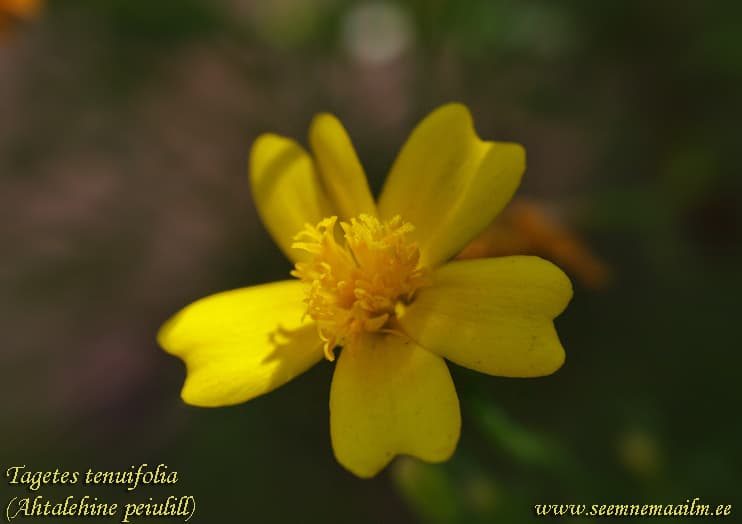Your shopping cart is empty!
Signet marigold "Lulu yellow-lemon"
Signet marigold "Lulu yellow-lemon".
Profuse and long flowering plant.
The plant is heat-loving, drought-resistant. Unpretentious to soils, prefers sunny places. To prolong flowering, faded flowers must be removed.
Used for planting in flower beds, groups on lawns, to decorate balconies. At a temperature of +18°C, the time from sowing to germination is 7-15 days.
Marigolds are unpretentious, fast-growing, light and heat-loving, drought-resistant plants. The optimum temperature for the growth of young plants is +18+20°C. At temperatures below +10°C, the leaves acquire an anthocyanin coating and growth stops.
At -1...-2 °C plants die.
Location: do not need intense sunlight, although maximum decorative effect is achieved in sunny places. This is especially true for thin-leaved marigolds. Poorly tolerate spring and autumn frosts.
Soil: require nutritious, well-moistened soils in the first half of summer.
Care: considered drought-resistant, but at the beginning of growth they need watering, otherwise the plants will be puny and the inflorescences small. Marigolds, especially erect marigolds, are negatively related to excess moisture in the soil. In rainy weather, their large inflorescences begin to rot. And if the soil is oversaturated with water, the plants begin to die from fungal root diseases. Spring fertilization entails strong growth and delayed flowering.
Use: secretions from the roots of marigolds reduce the damage of other plants by fungal diseases and especially Fusarium, protect against certain types of nematodes.
Marigolds erect can be grown for cutting. They stay in water for about three weeks. Marigolds are used in all types of flower beds (they are not suitable only for a pond and a shady garden).
They tolerate marigolds and harsh conditions of a small amount of soil. Therefore, they grow well in pots on the windows, they decorate the premises (as well as primroses or cineraria).
Marigolds can be planted in a pot or box in the fall before frost. There are cases that they survive in the winter, and in the spring they form a large flowering bush (this only applies to patula marigolds).
Profuse and long flowering plant.
The plant is heat-loving, drought-resistant. Unpretentious to soils, prefers sunny places. To prolong flowering, faded flowers must be removed.
Used for planting in flower beds, groups on lawns, to decorate balconies. At a temperature of +18°C, the time from sowing to germination is 7-15 days.
Marigolds are unpretentious, fast-growing, light and heat-loving, drought-resistant plants. The optimum temperature for the growth of young plants is +18+20°C. At temperatures below +10°C, the leaves acquire an anthocyanin coating and growth stops.
At -1...-2 °C plants die.
Location: do not need intense sunlight, although maximum decorative effect is achieved in sunny places. This is especially true for thin-leaved marigolds. Poorly tolerate spring and autumn frosts.
Soil: require nutritious, well-moistened soils in the first half of summer.
Care: considered drought-resistant, but at the beginning of growth they need watering, otherwise the plants will be puny and the inflorescences small. Marigolds, especially erect marigolds, are negatively related to excess moisture in the soil. In rainy weather, their large inflorescences begin to rot. And if the soil is oversaturated with water, the plants begin to die from fungal root diseases. Spring fertilization entails strong growth and delayed flowering.
Use: secretions from the roots of marigolds reduce the damage of other plants by fungal diseases and especially Fusarium, protect against certain types of nematodes.
Marigolds erect can be grown for cutting. They stay in water for about three weeks. Marigolds are used in all types of flower beds (they are not suitable only for a pond and a shady garden).
They tolerate marigolds and harsh conditions of a small amount of soil. Therefore, they grow well in pots on the windows, they decorate the premises (as well as primroses or cineraria).
Marigolds can be planted in a pot or box in the fall before frost. There are cases that they survive in the winter, and in the spring they form a large flowering bush (this only applies to patula marigolds).

Lemon marigold, lemon gem marigold, lemon mint marigold, signet marigold, slender-leaf marigold, striped Mexican marigold.












